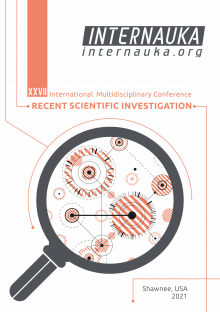UNIFIED INTERACTIVE SYSTEM FOR FIXING AND PLANNING ENVIRONMENTAL AND CLIMATIC CHANGE

UNIFORM INTERACTIVE SYSTEM FOR LOCATION AND PLANNING ENVIRONMENTAL AND CLIMATIC CHANGE
Markus Marrey
Electrical technicianб degree in "Relay protection and automation of electric power systems". Biology and chemistry teacher. Student at Swiss International Institute Lausanne,
Russia, Essentuki
ABSTRACT
Development of the concept of a uniform system for location changes in the field of ecology, climate, and agro-industrial complex. The options for the creation and implementation of a single system are presented, with consideration to the technical and financial capabilities of the country of implementation or cooperation of countries. An analysis of similar warning and control systems has been carried out. The work provides the substantiation of the advantages of a uniform interactive system over other analogs and the possibilities that this system gives to ecologists and the entire agro-industrial complex.
Keywords: neural networks, climate, ecology, agro-industrial complex, planning.
1. Introduction
Modern trends in the digitalization of the main areas of human activity enable increasing the volume and quality of produced resources. The development of control systems based on artificial intelligence can significantly reduce production costs, due to systematization, forecasting, and constant monitoring. Large investors, corporations, and governments in developed countries are realizing the need for digital technology development. The growth rates of the total capital invested directly in the field of information technology set new records, which led to the active growth of this segment and the technologies involved in it (Fig. 1). The introduction of new technologies into the agro-industrial complex occurs with a long delay in comparison with education or production. This comes from conservative thinking and economic difficulties, but the potential for applying new technologies in agriculture remains the most underestimated.
- The main areas of application of digital technologies in agriculture are:
- Monitoring the ecological state of the region and prompt updating. Fixation of emissions, pollution, and elimination process;
- General and public electronic research base;
- An interactive map with integrated databases and research, meteorological indicators, and with partial or full video recording from the research site;
- Control and study of the impact of certain events and decisions;
- Minimizing the impact of climate change, fires, and other natural disasters.

|
ИТ |
IT |
|
Строительство |
Construction |
|
Бизнес |
Business |
|
СМИ |
Mass media |
|
Образование |
Education |
|
Телеком |
Telecommunications |
|
Транспорт и логистика |
Mobility and logistics |
|
Финансовый сектор |
Financial sector |
|
Промышленность |
Industry |
|
Другое |
Other |
Figure 1. Share of investment in digitalization [1]
Observing the number of dangerous natural events over the past ten years gives evidence of a constant increase in disasters, fires, floods, and anthropogenic accidents (Fig. 2). In most cases, the responsibility lies with the authorities overseeing the environmental and technical safety of factories and industrial complexes, but it is necessary to consider the impact of climate change on the occurrence of weather phenomena unusual for certain territories.

Figure 2. Graph of the number of dangerous weather events for the year 2021 [2]
Development and applying a uniform interactive system for recording and planning environmental and climatic changes, allows preventing almost all of the above events, which can critically affect the well-being of people and the country, and cause long-term environmental, anthropogenic crises. The use of neural networks and machine learning with a large database of events may bring the possibility of accurate planning of events based on previous experience. The main advantage of the Interactive Change Recording System (ISFI) is the ability to observe and collect information in real-time from meteorological stations, researchers and scientists. Such a system can:
- predict the direction of fires and their exact boundaries;
- determine the scale of technical disasters;
- determine the exact temperature changes;
- control over the general ecological situation;
- control over the implementation of assigned tasks to certain services;
- forecast climate change and natural disasters.
2. Materials and Methods

Figure 3. Artificial intelligence market dimension, USD billion [4]

Figure 4. The volume of the cloud services market in the Russian Federation from 2017-2025, billion rubles [5]

Figure 5. Annual growth rate of cloud services in the Russian Federation from 2017-2025 [5]

|
Яндекс.Диск |
Yandex.Disk |
|
Другие |
Others |
Figure 6. Representatives of the cloud storage services market, % [5]
References:
- The article “Sectoral distribution of respondents to the research“ Digital IQ 2020 Russia”. Source: PwC and ABBYY Russia, February 2021, URL - https://www.itweek.ru/digitalization/article/detail.php?ID=216701
- The article “The weather is getting nervous. How does global climate change affect agriculture?”, URL -http://ikar.ru/old/press/5198.html.
- Yakovlev R.O., Tikhonova T.P., Khalafova E.S., Barannikova K.M. The main problems of agriculture in Russia // Actual problems of the humanities and natural sciences. 2015. No. 12-3. URL: https://cyberleninka.ru/article/n/osnovnye-problemy-selskogo-hozyaystva-v-rossii
- Author: Trofimov V.V. Article "Artificial Intelligence in the Digital Economy", URL - https://roscongress.org/materials/iskusstvennyy-intellekt-v-tsifrovoy-ekonomike/
- Article "Cloud services (Russian market)", URL - https://www.tadviser.ru/index.php/
